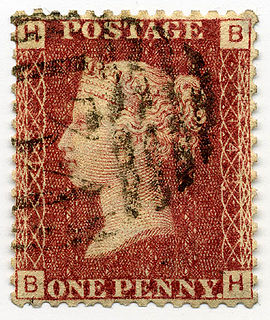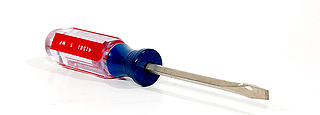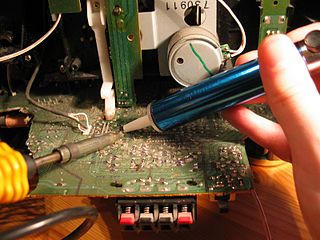
A forge is a type of hearth used for heating metals, or the workplace (smithy) where such a hearth is located. The forge is used by the smith to heat a piece of metal to a temperature where it becomes easier to shape by forging, or to the point where work hardening no longer occurs. The metal is transported to and from the forge using tongs, which are also used to hold the workpiece on the smithy's anvil while the smith works it with a hammer. Sometimes, such as when hardening steel or cooling the work so that it may be handled with bare hands, the workpiece is transported to the slack tub, which rapidly cools the workpiece in a large body of water. However, depending on the metal type, it may require an oil quench or a salt brine instead; many metals require more than plain water hardening. The slack tub also provides water to control the fire in the forge.

Philately is the study of postage stamps and postal history. It also refers to the collection, appreciation and research activities on stamps and other philatelic products. Philately involves more than just stamp collecting or the study of postage; it is possible to be a philatelist without owning any stamps. For instance, the stamps being studied may be very rare or reside only in museums.

Stamp collecting is the collecting of postage stamps and related objects. It is related to philately, which is the study of stamps. It has been one of the world's most popular hobbies since the late nineteenth century with the rapid growth of the postal service, as a never-ending stream of new stamps was produced by countries that sought to advertise their distinctiveness through their stamps.

A soldering iron is a hand tool used in soldering. It supplies heat to melt solder so that it can flow into the joint between two workpieces.

A spoon is a utensil consisting of a small shallow bowl, oval or round, at the end of a handle. A type of cutlery, especially as part of a place setting, it is used primarily for transferring food to the mouth. Spoons are also used in food preparation to measure, mix, stir and toss ingredients and for serving food. Present day spoons are made from metal, wood, porcelain or plastic. There are a wide variety of spoons that are made of a variety of materials and by different cultures for many different uses and foods.
Force spectroscopy is a set of techniques for the study of the interactions and the binding forces between individual molecules. These methods can be used to measure the mechanical properties of single polymer molecules or proteins, or individual chemical bonds. The name "force spectroscopy", although widely used in the scientific community, is somewhat misleading, because there is no true matter-radiation interaction.

A screwdriver is a tool, manual or powered, used for driving screws. A typical simple screwdriver has a handle and a shaft, ending in a tip the user puts into the screw head before turning the handle. This form of the screwdriver has been replaced in many workplaces and homes with a more modern and versatile tool, a power drill, as they are quicker, easier, and also can drill holes. The shaft is usually made of tough steel to resist bending or twisting. The tip may be hardened to resist wear, treated with a dark tip coating for improved visual contrast between tip and screw—or ridged or treated for additional 'grip'. Handles are typically wood, metal, or plastic and usually hexagonal, square, or oval in cross-section to improve grip and prevent the tool from rolling when set down. Some manual screwdrivers have interchangeable tips that fit into a socket on the end of the shaft and are held in mechanically or magnetically. These often have a hollow handle that contains various types and sizes of tips, and a reversible ratchet action that allows multiple full turns without repositioning the tip or the user's hand.

Hydraulic rescue tools are used by emergency rescue personnel to assist in the extrication of victims involved in vehicle accidents, as well as other rescues in small spaces. These tools include cutters, spreaders, and rams. Such devices were first used in 1963 as a tool to free race car drivers from their vehicles after crashes.
Linn's Stamp News is an American weekly magazine for stamp collectors. It is published by Amos Media Co., which also publishes the Scott Standard Postage Stamp Catalogue, the Scott Specialized Catalogue of United States Stamps and Covers, and the Scott Classic Specialized Catalogue of Stamps and Covers 1840-1940. Linn's was founded in 1928 by George W. Linn as Linn's Weekly Stamp News.

Tongs are a type of tool used to grip and lift objects instead of holding them directly with hands. There are many forms of tongs adapted to their specific use. Some are merely large pincers or nippers, but most fall into these few classes:
- Tongs that have long arms terminating in small flat circular ends of tongs and are pivoted at a joint close to the handle used to handle delicate objects. Common fire-tongs, used for picking up pieces of coal and placing them on a fire without burning fingers or getting them dirty are of this type. Tongs for grilling, tongs for serving salad or spaghetti are kitchen utensils of the same type. They provide a way to move, rotate and turn the food with delicate precision, or fetch a full serving in one grab.
- Tongs consisting of a single band of bent metal, as in sugar tongs, most asparagus tongs and the like. Sugar tongs are usually silver, with claw-shaped or spoon-shaped ends for serving lump sugar. Asparagus tongs are usually similar but larger, with a band near the head that limits how far the tongs can expand. Asparagus tongs for serving were introduced in 18th-century England, with smaller versions for eating asparagus appearing in the 19th century.
- Tongs in which the pivot or joint is placed close to the gripping ends are used to handle hard and heavy objects. Driller's round tongs, blacksmith's tongs or crucible tongs are of this type.

Repoussé or repoussage is a metalworking technique in which a malleable metal is shaped by hammering from the reverse side to create a design in low relief. Chasing or embossing is a similar technique in which the piece is hammered on the front side, sinking the metal. The two techniques are often used in conjunction.

Pliers are a hand tool used to hold objects firmly, possibly developed from tongs used to handle hot metal in Bronze Age Europe. They are also useful for bending and compressing a wide range of materials. Generally, pliers consist of a pair of metal first-class levers joined at a fulcrum positioned closer to one end of the levers, creating short jaws on one side of the fulcrum, and longer handles on the other side. This arrangement creates a mechanical advantage, allowing the force of the hand's grip to be amplified and focused on an object with precision. The jaws can also be used to manipulate objects too small or unwieldy to be manipulated with the fingers.

Forceps is a handheld, hinged instrument used for grasping and holding objects. Forceps are used when fingers are too large to grasp small objects or when many objects need to be held at one time while the hands are used to perform a task. The term "forceps" is used almost exclusively in the fields of biology and medicine. Outside biology and medicine, people usually refer to forceps as tweezers, tongs, pliers, clips or clamps.

Tweezers are small tools used for picking up objects too small to be easily handled with the human fingers. The tool is most likely derived from tongs, pincers, or scissors-like pliers used to grab or hold hot objects since the dawn of recorded history. In a scientific or medical context they are normally referred to as forceps.

In electronics, desoldering is the removal of solder and components from a circuit board for troubleshooting, repair, replacement, and salvage.
Diagonal pliers are pliers intended for the cutting of wire. The plane defined by the cutting edges of the jaws intersects the joint rivet at an angle or "on a diagonal", hence the name.

A fire iron is any metal instrument for tending a fire.
Electric tweezers are an electronic device intended to permanently remove hair. The design incorporates a pair of tweezers at the tip. A button on the side of the handle is used to simultaneously close the tweezer tips and turn on the high-frequency electrical signal. The electrical signal is intended to cause the connection of the hair to its root to be weakened and to stop hair growth from the root in a manner similar to electrolysis.
In robotics, an end effector is the device at the end of a robotic arm, designed to interact with the environment. The exact nature of this device depends on the application of the robot.

Postage stamp paper is the foundation or substrate of the postage stamp to which the ink for the stamp's design is applied to one side and the adhesive is applied to the other. The paper is not only the foundation of the stamp but it has also been incorporated into the stamp's design, has provided security against fraud and has aided in the automation of the postal delivery system.















